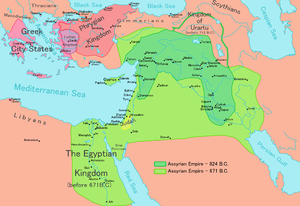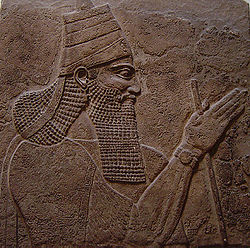
Tang-i Var
Encyclopedia
Tang-i Var is a Neo-Assyrian relief with a cuneiform inscription located in a narrow gorge at south of Palangan, about 50 km southwest of the city of Sanandaj,in the Iranian Kurdistan. It was discovered by A. Sarfaraz from Archaeological Service of Iran in 1968. With the help of Iranian army he managed to make casts and photographs. Later he published its report in the journal Majallah-i Barrasîhâ-i Târîkhi and described the figure on the relief and dated it to late second millennium or early first millennium.
The first Assyriologist to propose a date for the relief was Julian Reade, who in an article published in 1977 tentatively suggested that it might be attributed to Tiglath-pileser III or Sargon II (721-705 B.C.).This proposaI was based in part upon a tentative identification of the word [Man]nean(s) in the text.
Later G. Frame based on the photographs taken by Dr. François Vallat, translated the inscription and published it in 1999.
The inscription can be divided into five basic sections:
1. Invocation of various deities (lines 1-10)
2. Name and titles of Sargon II (lines 11-12)
3. Major accomplishments of Sargon's reign (lines 13-36)
4. Campaign to the land of Karalla (lines 37-44)
5. Creation of the commemorative inscription, and probably blessings
and curses
The tentative understanding of the lines assumes the following order of gods: Assur, Marduk, Nabû, Sin, Samash, Ishtar,and the divine Seven (Sebettu).
Ravansar
, a possible candidate for provincial city of Bit-Istar
is located about 30 km to the south of Tang-i Var.


The first Assyriologist to propose a date for the relief was Julian Reade, who in an article published in 1977 tentatively suggested that it might be attributed to Tiglath-pileser III or Sargon II (721-705 B.C.).This proposaI was based in part upon a tentative identification of the word [Man]nean(s) in the text.
Later G. Frame based on the photographs taken by Dr. François Vallat, translated the inscription and published it in 1999.
The inscription can be divided into five basic sections:
1. Invocation of various deities (lines 1-10)
2. Name and titles of Sargon II (lines 11-12)
3. Major accomplishments of Sargon's reign (lines 13-36)
4. Campaign to the land of Karalla (lines 37-44)
5. Creation of the commemorative inscription, and probably blessings
and curses
The tentative understanding of the lines assumes the following order of gods: Assur, Marduk, Nabû, Sin, Samash, Ishtar,and the divine Seven (Sebettu).
Ravansar
Ravansar
-See also:*Dekhmeh Rawansar*Khanileh*Jaff tribe*Ardalan*Javanroud*Paveh...
, a possible candidate for provincial city of Bit-Istar
Bit-Istar
Bit-Istar was a Assyrian town and a local kingdom at western Zagros that according to inscriptions of Tiglath Pileser III and Sargon II was located close to the source of a river to the east of Dyala....
is located about 30 km to the south of Tang-i Var.



